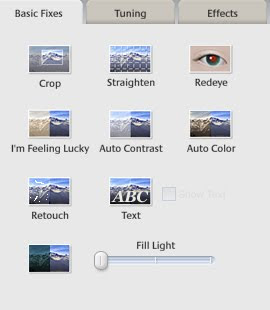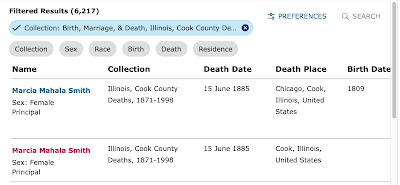 I was looking at FamilySearch’s historical records section over the holidays and noticed that the Soundex cards for Cook County naturalization were added on December 22. Now that they’re online for free, it seems like a good time to talk about Cook County naturalization research.
I was looking at FamilySearch’s historical records section over the holidays and noticed that the Soundex cards for Cook County naturalization were added on December 22. Now that they’re online for free, it seems like a good time to talk about Cook County naturalization research. In this post, I’ll focus on finding the records, but I’ll try to share some of the interesting things I’ve discovered about the Cook County naturalization process in another blog post soon.
If you're looking for Chicago and Cook County naturalization records you'll want to begin with the Soundex index to naturalization petitions for U.S. District & Circuit Courts, Northern District of Illinois and Immigration and Naturalization Service District 9, 1840-1950. (I just call it “The Soundex Index.”) It’s the same as NARA publication M1285 and it includes entries for people who naturalized in northern Illinois, northwestern Indiana, southern and eastern Wisconsin, and eastern Iowa.
Online Access to the Naturalization Soundex Index
There are two places to access the index online. If you have an Ancestry.com subscription you can search the cards by name, year of birth, year of arrival, and state of residence in U.S. Naturalization Record Indexes, 1791-1992 (Indexed in World Archives Project.
If you don’t have an Ancestry subscription, you can now browse the cards for free at FamilySearch.org. They’re included in the historical records part of the site in a database called Illinois, Northern District Naturalization Index, 1840-1950.
Browsing the Soundex Images
Here’s my approach to browsing the images:
1) Use the Soundex converter at Rootsweb to find the correct Soundex code. Type in the surname, hit the "Get Soundex Code" button and you're done.
2) Select the correct Soundex range from the choices available at FamilySearch. (The link in this paragraph will take you to the correct part of the FamilySearch site.)
Example: B-653 Tekla to C-124 means that section will include B-653 surnames with given names starting with Tekla and run through the end of the C-124 given names.
3) Find a card with the correct given name using a high-low number game strategy. There are 6586 cards in the section that would include Charles Berman (B-655). I'd type 3000 in the image number box to get my bearings. The corresponding card is B-656 with a G given name so I'd try a lower number. Typing in 1500 brings up a card for B-655 with a J given name so I'd try again. Typing in 700 brings up an A given name for B-655. The number 900 brings me to a B-655 card with the name Charles John. If I chose that as my starting point I'd page through the images going backwards until I had exhausted the entries for Charles or similarly-spelled names and then I'd return to image 900 and page through going forward if I hadn't found the match.
The introductory pages to this index remind researchers not to overlook "initials, alternate spellings, and "old country" versions of names." Good advice.
Locating the Naturalization Records
Once you’ve found a card and saved it to your computer, you’re ready to locate a copy of the corresponding naturalization record. Check the court. If it says Circuit, County, Criminal, or Superior, the original records are at the Circuit Court Archives. If it says District, the original records are held by NARA. Records from all the courts are also available on Family History Library microfilm.
1. Circuit Court Archives
I can suggest four ways to get naturalization records from the Circuit Court Archives.
In Person: The Circuit Court Archives has the Cook County Naturalization records from the Circuit Court, County Court, Criminal Court, and Superior Court. If you live in the Chicago area, you can visit their office on the eleventh floor of the Daley Center to view the records (free) and obtain photocopies (minimal fee). The office is easily accessible from the L and the staff is very helpful and friendly.
By Mail: If you can’t visit in person, you can request the records by mail, but it’s a two-step process. Once you submit the order form the office will bill you for the copies and then send them out when payment is received. The cost is $2.00 for the first page and $.50 for each one thereafter (a naturalization record would have just a few pages at most) + a $15 mailing fee + postage.
Important Information to Read Before Requesting a Search
Mail-in Request Form
From Family History Library Film: Using the new catalog at FamilySearch, pull up records for “Cook, Illinois” and then narrow the search by clicking on the link for Naturalization and Citizenship. This will bring up a list of available records and once you’ve identified the correct reel you can order it in at your local Family History Center.
From a Local Researcher: If you don’t live in the Chicago area, it might be quicker and/or easier to request a lookup from a local researcher rather than ordering by mail or ordering FHL films. I can retrieve naturalization records at the Circuit Court Archives if I’m going downtown (send me an email) or KimStankiewicz offers the service through our Genlighten.com website.
2. National Archives and Records Administration’s Great Lakes Regional Archives
If the court is listed as District, then the original records are kept at the National Archives and Records Administration’s Great Lakes Regional Archives, 7358 S. Pulaski Road, in Chicago.
In Person: If you’re going to go in person, contact them ahead of time to double-check the search procedure. I have next-to-no experience doing research at NARA but it took a couple of visits for my husband retrieved a naturalization record for someone last year.
NARA Naturalization FAQ
By Mail: NARA’s website says that naturalization records must be obtained by written request and that it can be done in person or by mail, fax, email, or online. I tried the online ordering link earlier today (4 Jan 2011) and it wasn’t working so I couldn’t learn more about how that process works. The fees page on their website suggests that there’s a charge of $.75 each for record copies and that there’s a minimum $15 fee for mail orders.
From FHL Film: The District Court naturalization records are available on Family History Library microfilm. If you have access to a Family History Center you can order in the reels and obtain the records that way. Here’s a quick link to the film numbers up through 1947.
From a FHL Researcher: If you don’t have access to a Family History Center or if you’d like quick access to digital copies of the naturalization records, jorgfe offers that lookup on our Genlighten.com website.
This post has grown much long and taken much longer than I expected to write and so I'll wrap things up with a couple of links to not-to-be-missed pages.
Important Information About Cook County Naturalization Records (learn what kinds of information you can expect to find depending on the year the naturalization papers were filed)
Cook County Naturalization Declarations of Intention Index (search the declarations index online)


















































